
CRACKING R-VALUES*
Has your architect given you insulation requirements that seem like a secret code? Those strange numbers can leave you feeling puzzled and frustrated. You've tried searching, asking around, and even calling technical support, only to wait on hold for 15 minutes and finally speak to someone who seems just as clueless as you are.
But here's the twist – this isn't a made-up scenario for this blog. It's the real-life struggle that our clients face when they reach out to us. The whole construction or renovation process, along with all the associated paperwork, can sometimes feel like a comedy show. Some people handle it better than others, but it's generally a stressful experience for all involved.
So, what if we could make this entire process a little more entertaining? In this article, we're going to simplify things and add a dash of humour to help you understand what you need to know (and what you can safely ignore). Keep reading, and you'll soon realise that it's not as complicated as it may seem. To stay on track, we'll zoom in on insulation R-values, unravelling this crucial element of energy-efficient building design.

WHAT IS R-VALUE? FUNNY AND SIMPLE EXPLANATION
 enerally speaking, R-value tells you how well a material stops heat from moving through it. In other words, it's the material's way of telling heat, 'You shall not pass!'
enerally speaking, R-value tells you how well a material stops heat from moving through it. In other words, it's the material's way of telling heat, 'You shall not pass!'

 Think of it like a warm winter coat. A high R-value is like a really thick, insulating coat that keeps you warm by blocking the cold air from getting in.
Think of it like a warm winter coat. A high R-value is like a really thick, insulating coat that keeps you warm by blocking the cold air from getting in.
So, when a insulation material has a high R-value, it's like having a super-warm coat for your house that keeps the heat inside and the cold out.

 Think of R-value like a leaky bucket. A material with a high R-value is like having a bucket with minimal leaks; it can hold water (heat) without it escaping easily.
Think of R-value like a leaky bucket. A material with a high R-value is like having a bucket with minimal leaks; it can hold water (heat) without it escaping easily.
On the other hand, a material with a low R-value is like a bucket with lots of holes, letting the water (heat) escape quickly. So, a high R-value material retains heat well, while a low R-value material loses it rapidly.

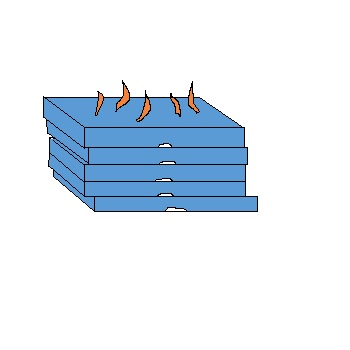
Think of R-value as a pizza delivery box. A high R-value is like having a top-notch, well-insulated box that keeps your pizza (heat) piping hot until it reaches your doorstep.
Meanwhile, a low R-value is like a flimsy, cardboard box that lets all the heat escape, leaving you with a lukewarm slice.
DOES DOUBLING UP INSULATION DOUBLE THE R-VALUE?
 ou've stumbled upon a deal for insulation that's as thin as a slice of cheese? You'll need to buy twice as much of it? But here's the real head-scratcher: will it still keep you as toasty as the thicker stuff? Does doubling up insulation double the r-value?
ou've stumbled upon a deal for insulation that's as thin as a slice of cheese? You'll need to buy twice as much of it? But here's the real head-scratcher: will it still keep you as toasty as the thicker stuff? Does doubling up insulation double the r-value?
Think about it like this: Of course! It's as simple as putting a leaking bucket inside another one to stop the water leak.
The same p rinciple applies to insulation. When you increase its thickness, you enhance its thermal resistance, reducing the amount of heat that can sneak away.
rinciple applies to insulation. When you increase its thickness, you enhance its thermal resistance, reducing the amount of heat that can sneak away.
Well, there you have it – as clear as day and as simple as making toast! If you double the thickness of your insulation, you're essentially giving its R-value a twin sibling. Double trouble, double warmth!
DO I WANT HIGH OR LOW R-VALUE? DOES A LOWER R-VALUE MEAN BETTER INSULATION?
 he tinier, the merrier; the colossal, the scarier – what's the deal with these mind-boggling formulas? You could go bonkers trying to etch them into your brain.
he tinier, the merrier; the colossal, the scarier – what's the deal with these mind-boggling formulas? You could go bonkers trying to etch them into your brain.
But why not opt for a comically artistic approach, you might ask? Why don't architects sketch a whimsical visual aid that makes understanding and memorising this as easy as pie?
Instead of tea, we've brewed up a picture for you!
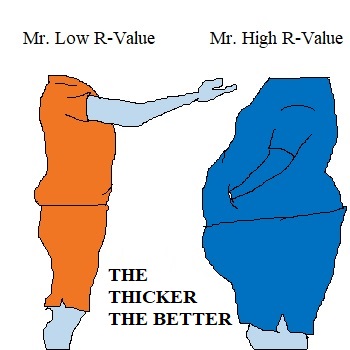
WHAT IS A GOOD R-VALUE FOR INSULATION IN THE UK?
 kay, picture this: you're in the UK, and you're wondering, "What's the deal with R-values for insulation?"
kay, picture this: you're in the UK, and you're wondering, "What's the deal with R-values for insulation?"
So, the big shots in the insulation world are phenolic boards from companies like Kingspan and Xtratherm (Unilin), and they can go as high as 7.85m²K/W. That's insulation bling, right there!
To figure out what's a good R-value, we take a look at the roof, which is like the hot spot for heat loss. The U-value for roofs is super strict (U-value-0.16 W/m²K).
So, a good R-value for insulation would be above 4.54m²K/W, but if you're feeling rebellious, 4.15m²K/W can do the trick.
Now, walls are no slouch either. A good R-value for walls is around 3.30m²K/W. That's the gold standard for keeping your house cosy.
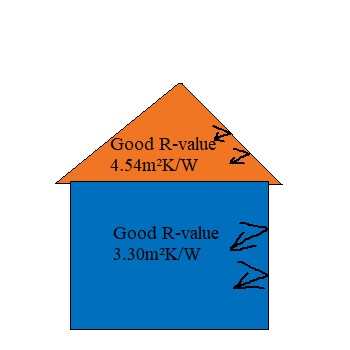
And here's the fun part - the R-values match the thickness of the insulation material:
GOOD INSULATION R-VALUES
 ood R-values correspond to the thickness of the insulation material:
ood R-values correspond to the thickness of the insulation material:
Phenolic board: 1x120mm
PIR rigid board: 1x140mm
EPS: 1x190mm
Mineral wool: 1x200mm + 1x100mm

Tab.1 Good R-value vs Insulation thickness
So, to sum it up, when you're on the hunt for the ultimate insulation, look for the ones with higher R-values. In the UK, a solid R-value would be around 4.15m²K/W, but if you want to be extra safe, aim for above 4.54m²K/W. Keep that cold at bay and stay cosy, my friend!
R-VALUE INSULATION CHART UK
 icking the right insulation in the UK is like choosing ice cream flavours—more fun with some tasty numbers! That's why we've whipped up a handy R-value chart below to make your insulation adventure as delightful as a trip to the gelato shop.
icking the right insulation in the UK is like choosing ice cream flavours—more fun with some tasty numbers! That's why we've whipped up a handy R-value chart below to make your insulation adventure as delightful as a trip to the gelato shop.
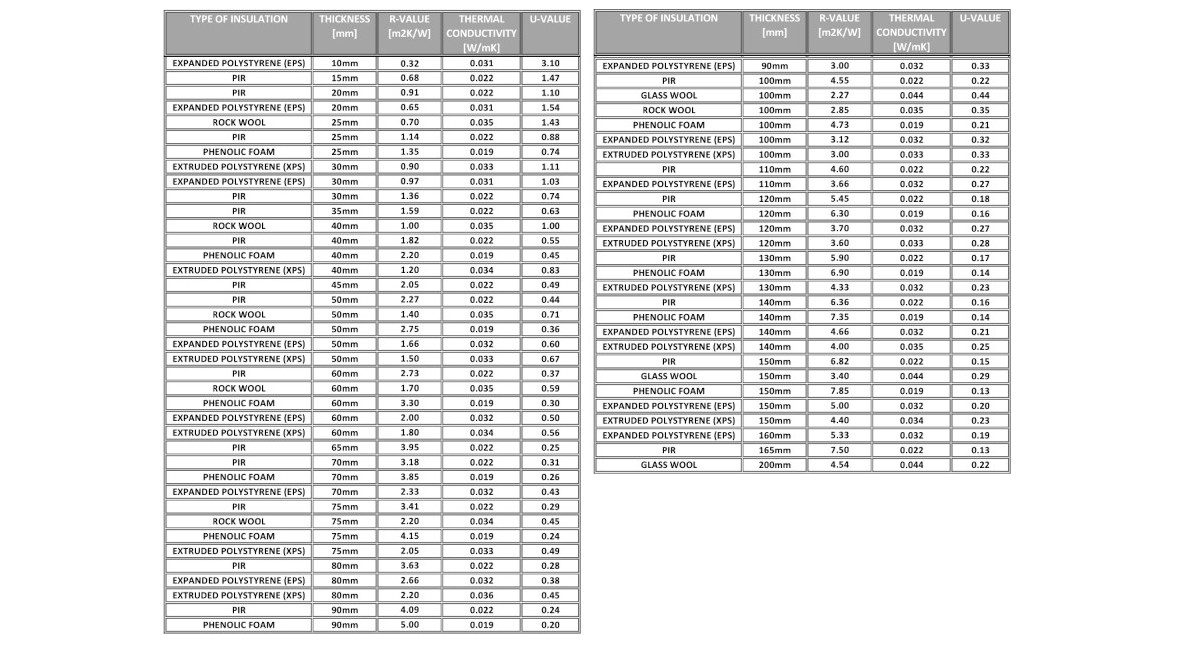
WHAT INSULATION HAS THE BEST R-VALUE?
 t's all about this R-value business, which basically tells us how good insulation is at playing hide-and-seek with heat.The heat transmission capability of an insulating material, as indicated by its R-value, should be practically tailored to the location in which we live in the UK.
t's all about this R-value business, which basically tells us how good insulation is at playing hide-and-seek with heat.The heat transmission capability of an insulating material, as indicated by its R-value, should be practically tailored to the location in which we live in the UK.
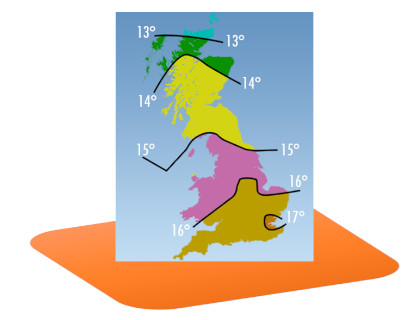
Picture credit: geographyinthenews.org.uk
So, in the north, where it's so chilly that even snowmen are eyeing one-way tickets to warmer lands, or down south, where the sun occasionally pops over from France just to say "Bonjour," you'll want different R-values. The difference in average UK temperatures is not that significant, so it has become common to use a single R-value for the entire United Kingdom.
In plain terms, the best insulation in terms of R-value is the one that offers the highest number while using the least amount of insulating material.To visualise which insulation has the best R-value, it's best to compare various types available in the UK market.
To figure out which insulation is the king of R-values, it's like staging a showdown in the UK insulation arena. We've got phenolic warriors from Unilin and Kingspan, PIR gladiators from Celotex and Recticel, polystyrene champions from Jablite and Stylite, and the mineral wool wizards from Rockwool and Knauf.
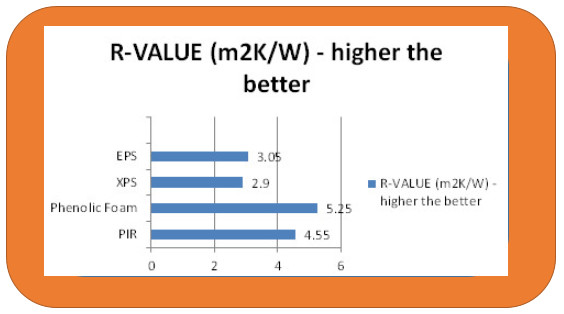
Pic. Best insulation with high R-value
As illustrated above, phenolic boards offer the highest R-values, closely followed by PIR boards. Polystyrene and mineral wool have the lowest R-values, thus offering the weakest thermal insulation performance.
WHAT CAUSES INSULATION TO LOSE ITS R-VALUE?
 here are several significant factors that can negatively impact the R-value of insulation. These troublemakers usually come from the outside world, like water, pests, and sneaky air infiltration. Even the ticking clock can conspire against your insulation, making it settle.
here are several significant factors that can negatively impact the R-value of insulation. These troublemakers usually come from the outside world, like water, pests, and sneaky air infiltration. Even the ticking clock can conspire against your insulation, making it settle.
However, the most common factor that reduces the R-value of insulation is its improper installation. It's like trying to wear your pants as a hat – it just doesn't work, and your insulation knows it. So, remember, a well-dressed home is a warm home!
R-VALUE ENEMIES: THE INSULATION INTRUDERS
WATER
 Water is one of the most significant adversaries when it comes to preserving the R-value of insulation.
Water is one of the most significant adversaries when it comes to preserving the R-value of insulation.
This is especially true for materials like mineral wool, including both stone wool and fibreglass wool.
To combat the infiltration of water, it's advisable to opt for low-absorbency materials like XPS, PIR, or Phenolic boards.
These choices provide an effective defence against moisture and help maintain the insulation's R-value.
PESTS
 Household pets are beloved by all Brits, but when it comes to wild animals living outside, it's a different story.
Household pets are beloved by all Brits, but when it comes to wild animals living outside, it's a different story.
They sometimes forcefully make their way into our homes, searching for food and shelter, and in the process, they can damage the insulation that offers them the least resistance.
These critters particularly love nesting in polystyrene.
PIR boards and spray foam insulation pose problems for them since they lack the necessary air space to survive.
Additionally, the aluminium foil on PIR boards is quite challenging for rodents to chew through.
When chasing the best R-value, you've got to keep all of this in mind.
AIR INFILTRATION
 Air infiltration is like a sneaky spy that creeps into your home through gaps and leaks.
Air infiltration is like a sneaky spy that creeps into your home through gaps and leaks.
It disrupts your insulation's job, making it less effective at keeping your home comfortable.
Proper sealing is the superhero solution to this problem.
In this case, the material you select takes a back seat; what truly matters is a well-sealed fortress to keep this unwelcome visitor at bay.
SETTLING
 Settling and deformation of insulation products can be synonymous with certain types of insulation.
Settling and deformation of insulation products can be synonymous with certain types of insulation.
This is unlikely to affect sturdy PIR boards with rigid edges.
The reason insulation settles is due to a shift in its centre of gravity caused by the product's durability.
Mineral wool is a prime example of this phenomenon.
AGING
 'Age is not a joy,' and that applies to insulation too.
'Age is not a joy,' and that applies to insulation too.
Sunlight, temperature fluctuations, and seasonal cycles all take their toll on insulation products over time.
The product becomes brittle, begins to let the cold in, and consequently, its R-value decreases.
Examples of such insulation include glass wool and polystyrene.
WHAT IS THE R-VALUE OF 100MM INSULATION?
 he insulation space in the UK isn't all that generous, typically falling within the range of 50 to 150mm. The most commonly chosen insulation thickness is 100mm. Therefore, having a good grasp of the R-value figures is quite essential. Below, we've put together an illustrative diagram to simplify it all.
he insulation space in the UK isn't all that generous, typically falling within the range of 50 to 150mm. The most commonly chosen insulation thickness is 100mm. Therefore, having a good grasp of the R-value figures is quite essential. Below, we've put together an illustrative diagram to simplify it all.
We've arranged everything in order from the R-value champs to the less-impressive contenders, so you can see at a glance which material takes the crown for your insulation needs.

Tab.2 100mm R-value insulation figures
WHAT IS THE R-VALUE OF 50MM KINGSPAN INSULATION?
 ingspan doesn't need an introduction; it's synonymous with insulation. With years of insulation expertise, a dedication to top-notch standards, and thorough product documentation, Kingspan has earned its stellar reputation.
ingspan doesn't need an introduction; it's synonymous with insulation. With years of insulation expertise, a dedication to top-notch standards, and thorough product documentation, Kingspan has earned its stellar reputation.
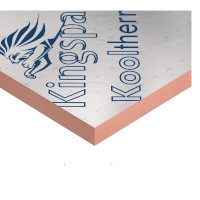 When space for insulation is at a premium, Kingspan comes to the rescue. They offer the best R-value for 50mm insulation, which is the minimum practical thickness worth considering.
When space for insulation is at a premium, Kingspan comes to the rescue. They offer the best R-value for 50mm insulation, which is the minimum practical thickness worth considering.
Kingspan provides the top R-value for 50mm insulation, boasting an impressive R-value of 2.75m²K/W. Meanwhile, another company offers an R-value of 2.35m²K/W for the identical 50mm thickness, representing a 14% reduction in thermal resistance.
WHAT IS THE R-VALUE OF 4 INCHES (100mm) OF ROCKWOOL?
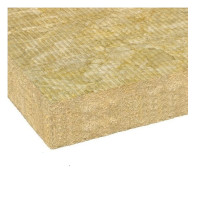 Rockwool holds a strong position in the world of insulation products, earning recognition as the second most prominent brand after Kingspan. While it may not have the same level of immediate recognition as Kingspan, it stands as a trusted and well-known choice among those well-versed in the realm of insulation materials.
Rockwool holds a strong position in the world of insulation products, earning recognition as the second most prominent brand after Kingspan. While it may not have the same level of immediate recognition as Kingspan, it stands as a trusted and well-known choice among those well-versed in the realm of insulation materials.
If we're talking about 100mm (4 inches) insulation thickness and planning to use Rockwool products, you should be aware that it will provide you with an R-value of 2.90m²K/W. This falls short of breaking the highest U-value threshold of for walls-0.30W/m2K (the least demanding U-value).
So, to meet the minimum R-value for walls, you would need to reach 3.30m²K/W, which means adding an additional layer of insulation with a thickness of 25mm.
CONCLUSION
Conclusively, R-Value is not just a number; it's the key to understanding insulation and maintaining a comfortable living environment. We've explored its importance in choosing the right insulation materials, considered factors that can affect R-Value, and even had a bit of fun along the way. From Kingspan to Rockwool, we've seen how different products stack up and why it's crucial to get the right R-Value for your specific needs. With a good dose of humor and a touch of insight, we've made R-Value more accessible and entertaining than ever.
Related articles:
WHAT TO CONSIDER WHEN CHOOSING INSULATION MATERIALS
VALUABLE TIPS FOR INSULATING A PITCHED ROOF BETWEEN RAFTERS
MASTERING THE ART OF CUTTING CELOTEX AND KINGSPAN INSULATION BOARDS: TECHNIQUES, TOOLS, AND SAFETY
DOUBLE INSULATION LAYERS: INSTALLATION TIPS
INSULATION THICKNESS ESSENTIALS
WHAT CAN GO WRONG WITH INSULATION? COMMON ISSUES AND SOLUTIONS
SMART THERMAL INSULATION THAT'S CHANGING THE GAME.
THE PRICE OF COMFORT: UNRAVELLING WHY INSULATION IS SO EXPENSIVE
BIBLIOGRAPHY:
1.insulationmanufacturers.org.uk, Thermal performance, 'R-value', accessed October 20, 2023
2.theretreat.pub, Bill Bailey, BRITISH PUB JOKES, accessed October 20, 2023
3.geographyinthenews.org.uk, The temperature divide, accessed October 20, 2023
*All the information provided in the content published on Insulationgo blog is for informational and educational purposes only. Insulationgo LTD makes every effort to ensure the accuracy and timeliness of the content, but we do not assume any responsibility for any errors or omissions.
The information presented on this blog should not be considered as professional advice or a substitute for consulting relevant experts. Before making any purchase decisions or taking action based on the information presented here, it is strongly recommended to contact the product manufacturer directly to verify the details and ensure its suitability for your specific needs.
Any descriptions, drawings, photographs, data, proportions, weights, measured values etc. given herein may change without prior notice and do not constitute the agreed contractual quality of the products. It is the responsibility of the recipient of all products to ensure that any proprietary rights and existing laws and legislation are observed.
By using this blog, you acknowledge and agree that Insulationgo LTD shall not be held liable for any damages, losses, or inconveniences arising from the use or reliance on the information provided herein. This limitation of liability applies to all users of the blog, including but not limited to visitors, readers, and subscribers.










































































































